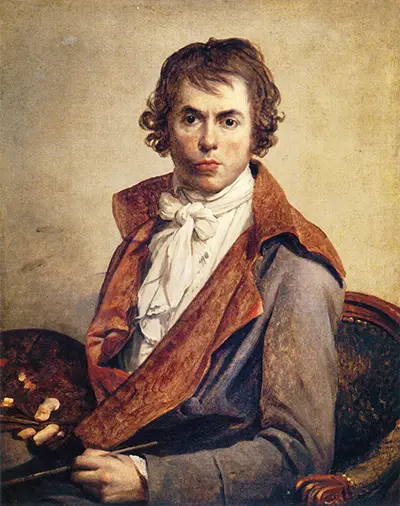 Buy Art Prints Now
Buy Art Prints Nowfrom Amazon
* As an Amazon Associate, and partner with Google Adsense and Ezoic, I earn from qualifying purchases.
No one could say that Jacques-Louis David had an unexciting life. He painted for the king before the revolution, was a friend with Robespierre – for which he was jailed – and then became enamoured of Napoleon, even painting Josephine prior to her marriage to the emperor.
Political trauma notwithstanding, he had already had to deal with his father being killed in a duel when the boy was just 9, and his mother's response to the situation was to leave her son with his architect uncles – perhaps a reason why, in David's early paintings at least, men were shown as proud and strong, with clean straight lines and defined musculature while the women are almost always smaller in scale, and depicted drooping, seated or otherwise in positions of weakness?
David painted three self-portraits, and this is the third (although he looks younger and less stressed in this than he did in the second, which is similarly posed. The second painting can be found in the Uffizi Gallery). As with many of his portrait paintings, this one offers no clue as to where he is, no clutter to define if he is in a kitchen, bedroom or even studio, and no glimpses through an artfully placed window to show natural elements, like the sea or a mountain. Instead the background is a textured taupe, a nicely neutral sandy brown, against which the brown curls of the artist stand out. He is seated side on to his view – presumably a mirror – and he is turned towards the audience, seeming to stare out with intense concentration.
All of David's paintings pay particular attention to the texture of things, especially fabrics and he could precisely depict silk, satin, cotton and velvet to name just a few. This painting shows this particular skill well, with the fall and drape of the smoking jacket that he is wearing to protect his clothes from paint spills. The jacket's wide smooth lapels can clearly be discerned in contrast to the thick, more textured fabric of the rest of the jacket. Under that, his cravat is beautifully tied, wrapped around his neck, in a bow, with the fall of fabric forming three evenly shaped scallop folds. His mouth is pursed and his brows drawn slightly together, while his eyes are dark and intense, focussing intently on what he is seeing.
While the left side of his face, catching the best of the light, is unblemished, it is possible to see, almost hidden in the shadows cast by the angle of the lamp, a large scar next to his mouth on the right-hand side. This scar, caused by a sword, apparently, gave him a lot of trouble over his lifetime. Wit and rhetoric were as desirable then as good looks are today, but the scar tissue from the blade caused a tumour to grow, interfering with his speech and preventing him from pronouncing some words clearly.
However, his adherence to honesty in his work also extended to his self-portrait, and while he might have diminished it as best he could, he included the injury in all the self-portraits. The painting hangs in the Louvre, painted in oil on canvas. It measures 81cm by 64cm and was the subject of a stamp from a 1950 series celebrating the Revolution.




